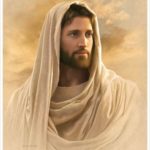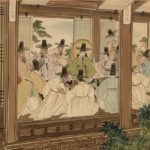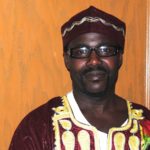Seeing Jesus (Click on the sermon title for a .pdf copy)
John 14:15-21
May 21, 2017
WWJD. What would Jesus do? You’ve probably heard the expression. You may have worn the bracelet. WWJD. What would Jesus do?
It’s a cue, a reminder, to frame the decisions we make and the actions we take in the context of Jesus’ way of thinking and acting. We decide what to do by supposing what Jesus would do if he were in our place, if he were facing a similar situation. If Jesus were here, what would he do?
But there is one flaw with this approach. It depends on supposing. I use imagination to posit what I believe Jesus would do, if he were here. But Jesus is here! I don’t have to imagine him. I can see him! The question is not “What would Jesus do?” but “What is Jesus doing?”
The world will see me no more, but you will see me …
That’s the promise Jesus made to his followers. “In a little while the world will see me no more” and it doesn’t. The world may remember Jesus, talk about him, diss him or disparage him or admire him, but the world doesn’t see him. To them, he is long dead, long gone. But we know he is not: “The world will see me no more, but you will see me.”
We can see him, because he lives. Before everything else, Christians are witnesses to the resurrection of Jesus. We are Easter people, eager to recognize and make ourselves a part of all that Jesus is doing among us and in our world here and now. We know Jesus is alive, because we can see him.
Where? Where do we see him?
In a little while the world will see me no more, but you will see me; and because I live, you also will live. When that day comes, you will know that I am in my Father and that you are in me, just as I am in you.
“Just as I am in you.” We see Jesus in and among his people, in and among all his people.
Do you see Jesus?



Which is the real Jesus? All of them. We use imagination to portray Jesus through the lens of our own cultures and experiences. We imagine a Jesus like us, because Jesus is like us!
Which is the real Jesus? None of them. Each of the images is equally true, but also equally false. The danger is that we will suppose any one of these images to be the one real Jesus, but that would be idolatry, making Jesus in my own image. Foisting a white European Jesus onto men and women from a different culture is an act of marginalization and oppression, not an act of evangelism.
That’s why it is so important for us to see Jesus through eyes other than our own, to hear the stories and learn from the experiences of people from other cultures and other worship traditions. It is edifying, spiritually enriching, to imagine a Jesus like me, but we don’t have to use imagination to be edified. Jesus is here. We can see him, as he is.
Do you see Jesus?



I do. I see Jesus in Jonathan, in his courage and in his love and loyalty to this church family.
I see Jesus in Kelly, coming to church last Monday, bringing his own equipment to do our lawns, helping Skyler out after the church’s mower broke down.
I see Jesus in Miah, gentle and fierce, gracious and truthful, seeing the world and its people with a clear eye, with all its flaws, with all our flaws, but bringing blessing, bringing wonder, bringing love.
I see Jesus in Adam Akin, bidding hundreds of dollars to win an auction of sports memorabilia, not to add to his collection, but to bless his sister, to add to the monies raised to help with her medical expenses.
I see Jesus in Bill and Vivian, two people very much like us, members of a church very much like ours in Des Moines, moved by the jeopardy of foreign-born neighbors, clearly motivated by their faith, by their love of God, not merely to care, but to do, to do something, even something hard, even something risky, to make love real.
I see Jesus in members of this church, coming to all four sessions of our series on the modern sanctuary movement, wanting to be there — even those with misgivings, even those with doubts — being there to listen, to listen carefully and to ask good questions, because it matters, because our neighbors matter.
I see Jesus in Jayne and Lynne, in Gina and Michelle, in Paul and Hannah and Samantha, people who devote time and energy and skill and passion, Sunday by Sunday by Sunday, investing themselves in the lives of our children, because they love them as if they were their own — because they are their own, our own! — investing themselves in each one of these children of God, to show them they are loved as they are and loved for the sake of what they may grow to be.
I see Jesus in our musicians — choir members, bell players, Ben and Miah — creating beauty and making an offering of praise. Music is intensely self-satisfying. It is joy to make music and to receive praise when it is done well. But as any musician can tell you, or anyone who loves to hear it, there is a place where you become one with the music and one with those you make it with and one with the God who is its source, a place where it’s not about you, but about being engulfed in the beauty and wonder and glory of God. Music as its best is prayer and prayer at its best is simply enjoying God, enjoying God’s presence, enjoying God’s being, enjoying being with God.
I was reminded of the power of music this last Wednesday morning. Rita Waggoner invited me to attend the recognition ceremony for participants in Hawkeye Metro Center’s English Language Learning program. Certificates were presented. Scholarships were awarded. Instructors and students and Waterloo’s Mayor Quentin Hart shared remarks.
But the highlight of the event was a song. Early in the program, a young and elegant Congolese woman sang the Congolese national anthem. She sang beautifully, but as she sang, she was joined by other voices, compatriots singing the song of their homeland, and all around me people began rising to their feet and soon we were all standing, all standing in honor, not just of a land, but of our neighbors, honoring their heritage, honoring them. Music was the vehicle to remember and express love for a homeland, love for a particular place and people, but at the same time, music was the vehicle to bring us together, to cross the divide between peoples. That day, it was not their anthem alone, but ours, all of ours.
That’s what music does. That’s what Jesus does.
These are some of the places I see Jesus. I see Jesus in many places, in many people, because, as the scripture says: “The Spirit’s presence (or we might say, the presence of the Spirit of Jesus) is shown in some way in each person for the good of all.” I am not suggesting that any of us are Jesus, but that Jesus is seen in us, in each of us, in some way.
And I do mean that quite literally. Jesus is present, Jesus may be seen, in us, as his Spirit, his way, his presence, transform and reshape us and make us to be more and more like him.
I see Jesus in many places and in many people, but this is when I know for sure that I have seen the living Jesus — when someone turns aside. That was Jesus: not sticking to the plan, keeping to the schedule, places to go and things to do, but turning aside, stopping in his tracks, taking time, precious time, to answer a question or to heal a wound or to sit a child on his lap. Jesus had time for you. Jesus turned aside for you. And when you turn aside, when you stop in your tracks, when you change your schedule or change your direction or change your mind, because you have been touched by another human being, I see Jesus in you.
Do you see Jesus? It’s not “What would Jesus do” but “What is Jesus doing?” What is Jesus doing … in you?
